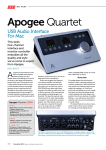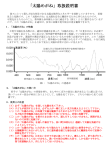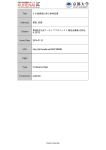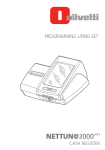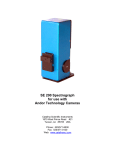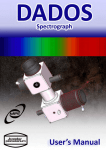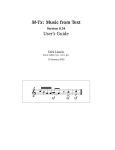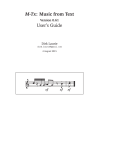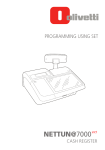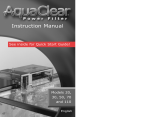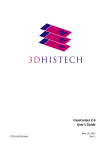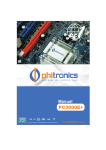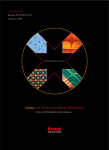Download SPECTROSCOPY
Transcript
SPECTROSCOPY CATALOG 2007 ©2007 Apogee Instruments Inc. 1020 Sundown Way, Ste 150 Roseville CA 95661 USA tel 916-218-7450 fax 916-218-7451 http://www.ccd.com 1020 Sundown Way, Ste 150 Roseville CA 95661 USA tel 916-218-7450 fax 916-218-7451 http://www.ccd.com HIGH PERFORMANCE FEATURED SYSTEMS COOLED CCD CAMERAS A DECADE OF IMPROVEMENTS pogee Alta and Ascent cameras are designed for a wide range of demanding scientific applications. In Ascent, we have reduced the size and cost of our electronics and housings, while at the same time maintaining the key features of our popular Alta Series cameras. We’ve added high-speed 16-bit electronics and some new sensors with resolutions up to 16 megapixels. The larger Alta cameras offer lower noise and deeper cooling than the Ascent cameras. They also support very high quantum efficiency back-illuminated CCDs. For both camera series, the direct USB 2.0 link between camera and computer allows easy installation, portability and fast data transfer rate. Ascent maintains compatibility with our Alta ActiveX drivers, as well as Linux and Mac OS X drivers. DIVERSITY ADDS STRENGTH Since 1993, Apogee Instruments has been manufacturing cooled CCD cameras for scientific applications. Our cameras are now used in more than 50 countries, from government and private research laboratories to the best of world-class professional observatories. Within spectroscopy, Apogee cameras have been used for a variety of techniques, including LIBS (laser-induced breakdown spectroscopy), Raman, atomic, emission, scanning and echelle spectroscopy. They have used for water, soil, and gem analysis; detection of anthrax; development of methods and technologies for detection of land mines and improvised explosive devices (IEDs); analysis and detection of contaminants at nuclear reactors. In other fields, our cameras have been used to image fingerprints without chemicals; x-ray inspection of car parts; fluorescent imaging of cell tissues and microtitre plates; munitions testing; laser beam profiling; poacher surveillance; mammography; optics testing; discovery of thousands of astronomical objects; and radiometry of a wide variety of light sources. By expanding into broad markets with diverse demands, Apogee has had to develop a wide variety of technologies to solve our customers’ problems. Our spectroscopy customers demand low noise, high sensitivity, and high quantitative accuracy. Our life science customers demand speed and ease of use. Both groups are constantly pushing for higher performance at lower prices. Ascent and Alta cameras address these demands. These back-illuminated CCD systems will be setting a new standard for low-cost specitroscopic systems. (Monochrome only) Camera Model A1109 A1108 A1107 Hamamatsu CCD S10141-1109 S10141-1108 S10141-1107 Array Size 2048 506 1024 250 512 122 A1009 S10141-1009 1024 A1008 S10141-1008 A1007 A98 Total Pixels 1036288 512000 249856 Pixel Size (microns) 12 12 12 506 518144 12 1024 250 256000 S10141-1007 1024 122 S9840 2048 14 Array size (mm) X 24.6 24.6 24.6 Y Imaging Area (mm2) Diagonal (mm) 6.1 3.0 1.5 149.2 73.7 36.0 25.3 24.8 24.6 12.3 6.1 74.6 13.7 12 12.3 3.0 36.9 12.6 124928 12 12.3 1.5 18.0 12.4 28672 14 28.7 0.2 5.6 28.7 HAMAMATSU: BACK-ILLUMINATED SPECTROSCOPIC FORMAT CCDs 100 INTEGRATION CD Apogee has collected all the specification sheets and machanical drawings for all camera models onto an Integration Starter Kit CD, together with software drivers and documentation. 90 80 70 60 50 40 30 20 10 0 200 220 240 260 280 300 320 340 360 380 400 420 440 460 480 500 520 540 560 580 600 620 640 660 680 700 720 740 760 780 800 820 840 860 880 900 920 940 960 980 1000 1020 1040 1060 1080 1100 A BACK-ILLUMINATED SPECTROSCOPIC FORMAT CCDs We continue to refine not just our electronics and our mechanical designs, but also our procedures, documentation, and customer recordkeeping. It’s quite an accomplishment to manufacture and sell thousands and thousands of cameras, but unless they are robust, the result is a customer service nightmare. In our effort to improve our process, we’ve achieved the following benchmarks: · FCC compliance · CE compliance · ROHS compliance · ISO-9000 compliance (in process) Absolute Quantum Efficiency (%) SYSTEM OVERVIEW Our most exciting new product for specitroscopy is a series of low-cost Ascent cameras using very high quantum efficiency Hamamatsu back-illuminated CCDs Wavelength (nm) Ascent Apogee Instruments Inc. 1020 Sundown Way, Ste 150 Roseville CA 95661 USA tel 916-218-7450 fax 916-218-7451 ©2007 Apogee Instruments Inc. Alta is a registered trademark of Apogee Instruments Inc. www.ccd.com Apogee Instruments Inc. Image / spectra may be acquired using KestrelSpecTM imaging spectroscopy software for Windows®. See pages 14-15 of this brochure of additional detail. www.ccd.com ASCENT versus ALTA SERIES CAMERAS Ascent Apogee Instruments Inc. LOWER COSTS COMPACT HOUSING Many applications require clean, quantitative images, but do not require the ultimate in cooling or low readout noise. The Ascent is an ideal solution for many applications where several thousand dollars may be more important than a few electrons. The Ascent’s smaller, more lightweight housing fits in many places that the larger Alta cannot. HIGHER THROUGHPUT Ascent was designed to operate at speeds up to the maximum allowed by USB2. Digitization speed is programmable so you can choose your ideal trade-off between speed and noise. All speeds digitize at a full 16 bits. LOW READOUT NOISE Alta’s readout electronics were designed to minimize readout noise. The higher speed software-selectable 12-bit mode is intended for focussing, and not optimized for low noise. ADVANCED COOLING To maximize heat dissipation, Alta’s large inner chamber, back plate, and heatsinks are machined from a single block of aluminum. The four fans have four programmable speeds. VERY LARGE FORMAT CCDS The Alta platform is available in several housing sizes, accomodating CCDs up to 50mm on a side. OPTIONAL ETHERNET An optional ethernet 100baseT interface is available for the Alta platform. The primary differences between the Ascent and Alta Series cameras: Ascent is very compact with much lower costs, much faster digitization, and programmable gain. Alta is larger, with better cooling, and lower noise electronics. See the chart below for an overview of the differences. See camera data sheets to get details of a specific model. Feature Ascent Alta SHORT BACK FOCAL DISTANCE Digitization 16 bit, programmable speed Fast 12 and slower 16 bit Maximum throughput Up to 20 Mpixels/sec (Note 1) Up to 7 Mpixels/sec (Note 1) Dual channel interline readout Standard N/A All Ascent cameras have short back focal distances of approximately 0.32” (0.8cm). Maximum cooling 40C below ambient (Note 2) 55C below ambient (Note 2) EMCCD SUPPORT The Texas Instruments TC247 EMCCD is supported in the Ascent platform. Programmable gain Standard N/A USB2 interface Standard Standard Ethernet 100baseT interface N/A Optional Electromechanical shutter Optional, external (Note 4) Standard, internal (Note 3) Vane shutter Standard, internal (Note 5) N/A Programmable fan speed N/A Standard Field upgradeable firmware Standard Standard Chamber window BK7 (optional fused silica) Fused silica Peripheral communications 8 pin connector Two serial COM outputs General purpose I/O port Standard Standard Programmable LEDs Standard Standard Power input 6V 12V Internal memory 32 Mbytes 32 Mbytes Wide variety of CCDs Yes Yes IMAGING FORMAT BACKILLUMINATED CCDs External triggering Standard Standard Image sequences Standard Standard Hardware binning Up to 4 x height of CCD Up to 8 x height of CCD Back-illuminated CCDs are much more expensive than front illuminated CCDs, so they are chosen when absolutely necessary for maximum signal-to-noise under low light conditions. Their higher dark current per square millimeter requires the higher cooling of larger Alta housing, with the exception of the small spectroscopic format backilluminated CCDs. Subarray readout Standard Standard TDI readout (Note 6) Standard Standard Kinetics mode Standard Standard C-mount interface (Note 7) Optional, external (Note 7) Standard for D1 housing Software universality Standard Standard Housing size 5.7” x 3.8” x 1.3” 6” x 6” x 2.5” (Note 8) Warranty 2 years 2 years Warranty against condensation Lifetime Lifetime Note 1 Note 2 Note 3 Note 4 Note 5 Note 6 Note 7 Note 8 Maximum speed varies from model to model. Maximum cooling varies from model to model. Electromechanical shutters are standard for full frame CCDs, and optional for interline CCDs. Electromechanical shutters are optional for all models. Vane shutters are standard for smaller full frame CCDs, optional for interline CCDs. Interline CCDs cannot do TDI readout. CCDs >1” video format are too large for C-mount optics (larger than a KAF-3200ME). Some housings are larger. ASCENT & ALTA: SHARED FEATURES INTERNAL MEMORY 32 Mbytes of SDRAM image memory is included in the Alta U Series and Ascent camera heads. 24 Mbytes of image memory is included in the Alta E Series camera head. Local memory serves some important functions: First, with any network connection and even USB2.0 connection, consistency in download rates cannot be guaranteed. Some manufacturers go to great lengths to attempt to lock Windows® up during downloads to ensure that no pattern noise results from breaks in the digitization process, but such a lockup is not possible with network interfaces. The Alta and Ascent systems buffer the image transfer to protect from noise-producing interruptions. Second, on heavily loaded USB2 ports, slower USB1.1 applications, loaded networks, or slower TCP/IP transfers, the maximum digitization rate could be limited without a local buffer. Local image memory allows very fast digitization of image sequences up to the limit of the internal camera. The maximum digitization-tomemory rates for 100baseT systems is 1.4 megapixels per second, while the maximum digitization-to-memory rates for Alta USB systems is 11 megapixels per second, and Ascent is 20 megapixels/second.. There is a fundamental difference in the way the Alta USB2 and network image buffers function. The USB2 image buffer is capable of transferring data to the host while digitization of the CCD is active. As long as the USB2 transfer speed is greater than the digitization rate, the memory buffer will never fill. The network memory buffer requires the image digitization to complete prior to transfer across the network. HARDWARE BINNING Every Alta and Ascent camera supports hardware binning up to 8 in the horizontal direction and up to the height of the CCD in the vertical direction. Binning can be used to increase frame rate, dynamic range, or apparent sensitivity by collecting more light into a superpixel. See additional detail under CCD University on our website. www.ccd.com ASCENT & ALTA: SPECIAL MODES OF OPERATION PROGRAMMABLE LEDs EXTERNAL TRIGGERING Two LEDs on the side of the cameras can be programmed to show status of a variety of the camera functions, such as the camera has reached the set temperature, the shutter is open, or the camera is waiting for an external trigger. Alternatively, the LEDs can be turned off if you are concerned about stray light. The E Series cameras also have two green LEDs that indicate status of the network connection. The Alta and Ascent camera systems accept external hardware trigger signals through their camera I/O ports for a number of purposes. Software and hardware triggers can be used together. For example, a software or hardware trigger may be used to initiate a single exposure or a sequence of exposures of a specific duration and specific delay between exposures. Alternatively, a software trigger may be used to start a sequence, and the external trigger can be used to trigger each subsequent image in the sequence. In addition, the external trigger can be used to trigger row shifts for time-delayed integration, or can be used to trigger block shifts for kinetic imaging. SOFTWARE SEALED INNER CHAMBERS MaxIm DL/CCD software is standard with every Alta, as well as an ActiveX driver that is universal to all Apogee Alta and Ascent cameras, as well as legacy AP and KX cameras. If you write custom code for an Apogee camera, you won’t have to change it later if you change models. Our cameras are also supported by other programs like CCDSoft. A Linux and Mac OS X drivers are also available. The sensors for Alta and Ascent cameras are sealed into an inner chamber filled with argon. The chamber has a lifetime guarantee against condensation. UPGRADEABLE FIRMWARE The Alta and Ascent systems load all camera operating code on camera start. These configuration files can be updated via the web as we add features and make improvements. Each camera head has coded information identifying the type of system, its configuration, and type of CCD used, as well as the firmware revision in use. This allows automatic configuration of the camera in the field and better customer support from our offices. PROGRESSIVE SCAN (CONTINUOUS IMAGING) Interline transfer CCDs first shift charge from the photodiode in each pixel to the masked storage diode, and then march the charge through the storage diodes to the serial register. Acquisition of a new image in the photodiodes during readout of the previous image is called “progressive scan.” Alta and Ascent cameras both support progressive scan with interline CCDs. TIME-DELAYED INTEGRATION KINETICS MODE IMAGE SEQUENCES More formally known in astronomy as time-delay integration (TDI), this technique is a powerful tool for applications requring the scan of an area larger than the CCD’s field of view. The image is clocked down the CCD in syncronization with the object’s movement. The CCD must be precisely aligned with the movement of the scene. The simplest way to illustrate TDI is an astronomical application. The telescope is kept stationary, and the CCD is precisely aligned with the sky. As the Earth rotates and the sky drifts, the image on the CCD is precisely clocked to continue building the image. When the image reaches the last row, it is read to the host computer and added to a continuous strip of sky. The TDI capability utilizes a 25 MHz time base (Ascents use a 48 MHz time base) and local memory to achieve consistent high resolution performance. TDI mode allows the user to adjust the row shift rate. Timing may be adjusted in 5.12 microsecond increments to a maximum of 336 milliseconds per row shift. The minimum TDI shift time is the digitization time for one row. TDI cannot be done with cameras using interline CCDs, such as the U2000 and U4000. Kinetics Mode assumes that the user has optically masked off all but the top most section of the CCD. This exposed section is illuminated, shifted by x rows, then exposed again until the user has exposed the entire surface of the CCD with y image slices. Image sequences of up to 65535 images can be acquired and transferred to camera / computer memory automatically. A delay may be programmed between images from 327 microseconds to 21.43 seconds.(This does not mean you can acquire images every 327 microseconds; it means you can program a delay of 327 microseconds between the end of a readout and the start of the next exposure.) TWO-YEAR WARRANTY All Apogee cameras have a standard two-year warranty and a lifetime guarantee against condensation in the camera. The image in the exposed area is shifted to the masked area per software command, preset shift frequency, or external trigger. The number of rows per section is predetermined and constant. FACE PLATE ADAPTERS Flange adapters allow you to attach anything from an SLR camera lens to a large instrument pack to your Apogee camera. We have sizes to fit all Alta and Ascent cameras. These units are machined precisely for accurate concentricity. www.ccd.com Application-Driven Sequencing: This is the most common form of image sequencing. The application merely takes a specified number of successive images. This type of sequencing is suitable when the time between image acquisitions is not short and where slight differences in timing from image to image are not important. Precision back to back sequencing Alta and Ascent incorporate a firmware controlled back to back image sequencing mode suitable for image-image intervals from 327uS to a maximum of 21.43 seconds in 327uS intervals. This provides for precision spacing of images in a sequence where windows applications cannot respond. When the number of desired exposures has been reached, or the CCD has been filled (whichever comes first), the entire array is read out and digitized. If you want to use the entire CCD including the exposed area, then the light source needs to be shuttered after the final exposure (externally, electronically, or electromechanically). or using an SUBARRAY READOUT Alta and Ascent cameras support readout of an arbitrary sub-section of the array in order to speed up frame rate. Reading half the array, for example, does not increase the frame rate by two because of overhead required in discarding unwanted pixels. The Ascent and Alta platforms allow for three types of image sequencing: Fast back to back sequencing (Ratio Imaging - Interlines only) This is a special form of precision back to back sequencing designed for a fixed <1 microsecond spacing between a pair of interline CCD exposures. The caveat with this mode is that the exposure times for each image must be greater than the readout time for the image. For example, if using the A2000, the readout time for a full frame is about 0.2 seconds so your exposure would need to be in excess of 0.2 seconds. ALTA SERIES CAMERAS: 0VERVIEW ADVANCED COOLING DUAL DIGITIZATION OPTIONAL ETHERNET SHUTTERS COMPACT DESIGN The Apogee cooling system has long been one of the most advanced in the industry. The Alta control system has been expanded to 12 bits, allowing a temperature control range of 213K to 313K (-60 to +40 C) with 0.024 degree resolution. Sensors have been added to monitor the heat sink temperature. A power indicator has been added to give the user an idea of how much drive is being given to the CCD cooler. The automatic back-off function is now handled by the firmware and driver. If the system cannot reach the desired temperature, the system automatically backs off to a point where regulation can be maintained, 2 degrees above the maximum temperature reached. The new set point is given to the user. Cooling deltas of 40-60C (depending on sensor area) are typical with simple air cooling. Apogee now offers liquid recirculation backs for Alta cameras. For customers desiring greater temperature performance where the camera housing will not go below the dew point, specifying liquid recirculation will assure a lower dark count than is possible with forced air cooling. With our fast USB2 systems, we offer dual digitization: high precision, low noise 16 bit performance as well as high speed 12 bit for focussing and other high frame rate needs. Digitization depth is selectable image by image in software The Alta E Series cameras first read the entire image into the camera head memory, and then transfer the image to the host computer at a maximum of 200 kpixels/second. An Alta U47 camera with 1 megapixel reads the entire image to the computer in about 1.5 seconds. An E47 reads the image to the camera memory in 1.5 seconds, but then requires an additional 5 seconds to transfer the image to the host computer. Apogee Instruments uses the finest shutters available for our cameras from Vincent and Melles Griot. These shutters have been carefully integrated into our camera heads with minimum impact on back focal distance and camera size. These shutters have a huge advantage of simple rotating blade shutters in terms of light blockage and minimum exposure time. The Alta systems are designed to be very compact. At 6”x6” and only 2.2” thick with no external electronics, the Alta system packs a lot of power into a small package. The Alta systems are more than a kilogram lighter than than their predecessor. Alta cameras with small format CCDs have a 0.69” (17.5 mm) C-mount back focal distance for direct interface to microscopes and C-mount lenses. Medium format sensors use the D2 housing with 2” thread. Large format sensors use the D7 housing with a 2.5” thread. Back focal distance for the D2 and D7 housing is approximately 1.04” (26.4 mm). All cameras have a bolt circle with metric threads for adaptation to a wide variety of flanges. PROGRAMMABLE FANS Some customers require a complete absence of vibration during an exposure. The Alta systems have been designed for complete control of the cooling fans. The fans may be turned off, or run at a much slower speed to maintain adequate cooling with no vibration. For applications where vibration is not an issue, the fan speed may be maximized for greatest cooling. The fans used in the Alta system were selected for minimum vibration. www.ccd.com MGF2 COATED FUSED SILICA OPTICS UNIQUE MAC ADDRESS Professional grade details like magnesiumflouride coated fused silica windows. Apogee also offers custom windows, including wedge windows and customer supplied optics. SINGLE 12V POWER SUPPLY Alta camera systems include a 12V international power supply (100V-240V input), but can be operated from a clean 12V source. The Alta E Series cameras each have a unique MAC address so they can be plugged directly into the internet for remote operation. We provide MaxIm software for remote control of the camera. They cannot be controlled through your browser. Because the camera has slave serial, I2C, and auxiliary filter wheel support, an entire setup can be controlled from behind a single camera interface. For WAN or WWW connections, a full TCP/IP protocol gives safe data transfers at slower speeds. A special bi-directional digital interface with 6 I/O lines can also be used to interface to other system components. High level shutter signals, as well as digital strobes and triggers, are available. LIQUID CIRCULATION CABLE LENGTH Ethernet cabling can go to 100m. USB2 cables are limited to 5m between hubs, with up to 5 hubs, for a total of 30m. However, there are USB1 and USB2 extenders available for operation up to 10 km. The USB1 extenders slow the transfer to a maximum of 500 kpixels per seoond, but this rate is still a far higher throughput than the E Series systems. USB2 extenders are available using Cat5 cable or fiber optic cable. Specifications subject to change without notice. Apogee offers Alta and Ascent liquid recirculation backs for customers wanting to remove heat dissipation from the area of the camera; wanting to house the camera inside an enclosure; or wanting supplemental cooling. The limitation: the temperature of the recirculating liquid must not go below the dew point. OPTIONAL LOW PROFILE HOUSINGS Lower profile housings are available for all Alta models to achieve <0.5” (<12.7mm) back focal distances without internal shutters. TWO SERIAL COM PORTS & GENERAL I/O PORT Our general purpose I/O port can tell you when the shutter is open, or can be used for a wide variety of external trigger inputs, including line-by-line control of TDI shifts. Our two serial COM ports can control peripherals like filter wheels through the camera’s control cable (USB2 or ethernet). Alta cameras use three shutter types, depending on the aperture. Apogee shutters use lower voltage coils then those listed as standard by the shutter manufacturers, roughly 1/2 of the standard voltage requirement. The lower voltages extend the lifetimes of the shutters. D1 housing, small format sensors: Vincent Uniblitz 25mm Shutter D2 housing, medium format sensors: Melles Griot 43mm Shutter D7 housing, large format sensors: Melles Griot 63.5mm Shutter Full frame CCDs typically require an electromechanical shutter unless the light source is gated in some other way. Otherwise light falling on the sensor during the readout process corrupts the image. Interline CCDs shift the charge from the photodiode section of each pixel to the masked storage diode. For low light applications, the mask is sufficiently opaque to prevent smearing. However, in high light applications, interline CCDs require electromechanical shutters to prevent smearing during readout. Specifications subject to change without notice. www.ccd.com ASCENT SERIES CAMERAS: 0VERVIEW PROGRAMMABLE DIGITIZATION Unlike previous generations of Apogee cameras with fixed digitization rates for each bit depth, the Ascent cameras feature programmable readout rates using 16-bit digitization. You can choose the best tradeoff between noise and readout speed imageby-image. Some CCDs, like the interline transfers, can read two channels at up to 10 MHz each, for a total throughput of over 20 megapixels per second. Other CCDs, like the full frame Kodaks, typically have a maximum useful throughput rate of about 7 to 10 MHz. See individual data sheets for specifics regarding each camera system. PROGRAMMABLE GAIN AND OFFSET All Ascent models feature programmable gain and bias offset programmable in the analog-to-digital converter. EMCCD SUPPORT The EMCCD is unique among CCDs. It has a special charge multiplication circuit that intensifies charge on-ccd before readout. Gains of 1 to 2000 are possible on-ccd using this technology, resulting in detection of extremely low light levels. With a gain of 1, the ccd behaves much like a normal CCD with a maximum well depth of 28Ke- and a typical noise of 20e-. With higher gains, ccd output noise approaches 1e- with a severe reduction in usable well depth. The A247 uses an interline frame transfer CCD, eliminating the need for a mechanical shutter and reducing smear. COMPACT DESIGN The Ascent systems are extremely lightweight (0.6 kg) and compact. At 5.7” x 3.2” (14.5 x 8.1 cm) and only 1.2” (3 cm) thick with no external electronics, the Ascent is a marvel of compact electronics. The standard back focal distance for all models is about 0.32” (0.8 cm). OPTIONAL LIQUID CIRCULATION CCD SELECTION C CDs come in many shapes and sizes, as well as several different architectures. Some architectures were developed specifically to address the needs of extremely low light applications like spectroscopy and astronomy (back-illuminated CCDs). Other technologies can be adapted to spectroscopy with excellent results, but a bit more patience and diligence may be necessary (interline transfer CCDs). Here are some ideas to keep in mind: QUANTUM EFFICIENCY Higher sensitivity = higher quantum efficiency = shorter exposures to get the same results. The peak value of a quantum effiiciency curve does not tell the full story of a CCD’s sensitivity. The area under the curve gives the true comparison of a CCD’s relative sensitivity. Twice the area under the curve = half the time making the exposure. Or, use the same exposure time, but get twice the signal. Apogee supports back-illuminated, front-illuminated, and interline transfer devices. Back-illuminated CCDs have the highest overall sensitivity. However, they are subject to etaloning (aka “fringing”) in the near-infrared. Front-illuminated CCDs are much less expensive than back-illuminated CCDs. UV & NIR WAVELENGTHS ANTI-REFLECTIVE COATED BK7 OPTICS The standard chamber window for the Ascent system is low cost BK7. An optional fused silica window is also available for applications requiring higher throughput in the ultraviolet. VANE SHUTTERS Ascent cameras with full frame CCDs have internal shutters intended to prevent smearing during readout for low light applications. The same professional-grade electromechanical shutters available as standard and internal in the Alta cameras are also available as housed external options with the Ascent cameras. www.ccd.com Apogee offers optional Ascent liquid recirculation back as well as temperatureregulated liquid recirculators for customers wanting to remove heat dissipation from the area of the camera; wanting to house the camera inside an enclosure; or wanting supplemental cooling. The limitation: the temperature of the recirculating liquid must not go below the dew point. SINGLE 6V POWER SUPPLY Ascent camera systems include a 6V international power supply (100V-240V input), but can be operated from a clean 6V source. Specifications subject to change without notice. Between 200-300 nm: Hamamatsu and E2V Back-illuminated UV enhanced CCDs; E2V open electrode CCDs (U30 only); TI EMCCD (EM247 only). Between 300-400 nm: most Kodak CCDs have zero QE at 300 nm, increasing linearly to >40% at 400 nm. Near Infrared: Back-illuminated CCDs have the highest QE, but they are also subject to fringing (also known as “etaloning”) in the near-infrared (simply put, the light is reflected inside the CCD itself). Some companies have developed proprietary versions of CCDs that minimize, though not eliminate, the effect. PIXEL SIZE The smaller the pixel, the lower the signal that can be stored in the pixel (“full well capacity”). If the noise per pixel is the same for two cameras, lower full well means lower signal-to-noise, or compromised image quality. CCD SELECTION DYNAMIC RANGE E2V CCDs: AIMO & NIMO INTERLINE TRANSFER CCDs Interline transfer CCDs have, at most, a full well capacity of about 50K electrons. If the electronics limits the read noise to 8-10 electrons, this is a dynamic range of 50K/10 = 5000:1, or about 12.3 bits. Most argue for oversampling by an extra bit, or some argue even two. However, a 16-bit analog-todigital (AtoD) converter does not upgrade a 12 bit imager into a 16 bit imager. A Kodak KAF-1001E (Alta U6 camera), using the low noise (aka high gain) output amplifier, can be operated at 6 electrons noise with a full well of 200K electrons, or a dynamic range of more than 30K:1, about 15 bits. E2V’s AIMO (Advanced I Metal Oxide, aka MPP) CCDs have hundreds of times less dark current than non-IMO (NIMO) CCDs. Some variations of their CCDs, such as deep depletion devices with high QE in the near IR, are only available as NIMO devices. Interline transfer CCDs, up to the scale of 35mm film, have inherent anti-blooming, but less dynamic range and lower quantum efficiency than Kodak’s other frontilluminated offerings. Interlines also have high dark current in the storage diodes, as well as some leakage through the storage diode masks. Mass markets for interline CCDs mean much lower prices per pixel, and a great entry point into professional level imaging. Because interline CCDs shutter the exposure by shifting the charge from the photodiode section of the pixel to the storage diode of the pixel, exposure times can be as short as a few microseconds. Time between exposures is determined by the time required to read out the entire CCD, which varies from camera to camera. Interline transfer CCDs cannot do timedelayed integration (also known as “drift scan” mode) because charge is not transferred from photodiode to photodiode, but rather into the masked storage diode. CCD GRADES Each manufacturer’s specification sheet for an imager defines the cosmetic grades for that specific imager. Different manufacturers use different procedures; a grade 1 of Imager A may allow column defects, but a grade 2 (lower grade) of Imager B may not. Kodak usually grades their CCDs at about 25°C, and most of their defects disappear in cooled cameras when the images are flat-fielded. In most cases, you cannot see the difference between the grades. Other companies, such as E2V, grade their CCDs at low temperatures, so their defects are less likely to disappear when the CCD is cooled. Defects on CCDs do not grow over time, nor do lower grade CCDs wear out faster. Most lower grade Kodak CCDs no longer allow column defects. These lower priced CCDs are excellent bargains. You may get an unwanted surprise if you do not check the data sheets for each CCD carefully before purchasing a system. Some large format CCDs allow several column defects in the “standard grade” CCD, DARK CURRENT Thermally generated signal, or dark current, is not noise. The shot noise component of the dark current is one element of noise, which is the square root of the dark current. You can correct for the dark current itself if you can measure it, which requires the camera’s cooling to be programmable and stable. The deeper the cooling, the less correction you’re going to have to do. KODAK BLUE PLUS CCDs CCDs create charge due to the photoelectric effect. In order to create an image rather than random electricity, the charge must be held where it was created. “Traditional” CCDs using from one to four polysilicon gates carry a voltage that traps the charge until transferred. Polysilicon has limited transmissivity. Indium tin oxide (ITO) gates have higher transmissivity, but lower charge transfer efficiency. Kodak’s combination of one polysilicon gate and one ITO gate is marketed as Blue Plus (because of the increase in blue sensitivity). The overall sensitivity of Blue Plus CCDs is much higher than multi-phase front-illuminated CCDs using only polysilicon gates. However, when researching point sources of light, it is good to keep in mind that there is a marked increase in quantum effiiency on the ITO side of each pixel. (See MICROLENSES below). MICROLENSED CCDs Many CCDs now use microlenses over each pixel. In the case of interline transfer CCDs, the microlenses focus the light onto the photodiode. In the case of Blue Plus CCDs (see above), the microlenses focus the light onto the ITO gate side of the pixel. Microlenses greatly improve overall quantum efficiency, but introduce some angular dependency. Fill factor is normally less than 100%. See data sheets for individual CCDs for details. www.ccd.com ANTI-BLOOMING Anti-blooming (AB) bleeds off excess charge from individual pixels so that it does not spill over into its neighbors and cause a white stripe down the column. For applications like astrophotography, AB preserves the aesthetics of the image. For photometric applications, AB can be used if exposure times are carefully controlled to avoid excess charge. The disadvantages of AB: normally it lowers full well capacity and quantum efficiency. SPECSMANSHIP CCD manufacturers as well as camera manufacturers both describe their products in terms of typical performance, and in some cases, specify worst acceptable performance. A CCD data sheet may, for example, say “typical 15 electrons noise” and “maximum 20 electrons noise” (under very specific and perhaps irrelevant conditions). As a result, camera manufacturers using such a CCD must also use “typical performance”, or sort CCDs at a potentially large increase in cost. The difference between typical and guaranteed is sometimes large, such as a factor of two in dark current. CCD SELECTION CCD SIZES BACK ILLUMINATED 177 27.4 FRONT ILLUMINATED FRONT-ILLUMINATED CCDs 3058 3058 9351364 12 36.7 36.7 1346.6 51.9 M A8300 KAF-8300 3448 2574 8875152 5.4 18.6 13.9 259 23.2 M,C U9, A9 U10 U32, A32 KAF-6303E 3072 2048 6291456 9 27.6 18.4 509.6 33.2 M TH7899* 2048 2048 4194304 14 28.7 28.7 822.1 40.6 M KAF-3200 2184 1472 3214848 6.8 14.9 10.0 148.7 17.9 M KAF-1603ME 1536 1024 1572864 9 13.8 9.2 127.4 16.6 M U13 KAF-1301E 1280 1024 1310720 16 20.5 16.4 335.5 26.2 M U6 KAF-1001E 1024 1024 1048576 24 24.6 24.6 604.0 34.8 M KAF-0402ME 768 512 393216 9 6.9 4.6 31.9 8.3 M KAF-0261E 512 512 262144 20 10.2 10.2 104.9 14.5 M U2, A2 U1, A1 U260, A260 A340 KAI-0340 Array Size 4872 3248 4008 2672 2048 2048 1600 1200 648 484 CAMERA DATA SHEETS Total Pixel Size Array size (mm) Imaging Area Diagonal Mono=M Pixels (microns) X Y (mm2) (mm) Color=C 15824256 7.4 36 24 866.5 43.3 M,C 10709376 9 36 24 867.5 43.3 M,C 4194304 7.4 15.2 15.2 229.7 21.4 M,C 1920000 7.4 11.8 8.9 105.1 14.8 M,C 313632 7.4 4.8 3.6 17.2 A complete set of camera data sheets as well as mechanical drawings are on our Integration Starter Kit CD, or at www.ccd.com 5.99 Wavelength UV Enhanced OE Broadband FRONT-ILLUMINATED CCDs A105 A8300 100 90 80 U2 E2 A2 U32 E32 A32 INTERLINE TRANSFER CCDs Kodak CCD KAI-16000 KAI-11002 KAI-4021 KAI-2021 Midband BI U260 E260 A260 U1 E1 A1 INTERLINES *The U10 uses an E2V (formerly Atmel, formerly Thomson) TH7899 CCD. Camera Model* A16000 A11000 U4000, A4000 U2000, A2000 0 U9 E9 A9 96 0 KAF-09000 10 A16000 A11000 U4000 E4000 70 60 50 40 30 20 U2000 E2000 EMCCD EM247 10 0 A340 M,C Wavelength (nm) www.ccd.com Back-illuminated Kodak Blue Plus Microlensed KAI-11002 10 00 U9000 U10 E10 1000 C 92 0 32 88 0 475 960 17.8 84 0 26.6 920 6.8 80 0 10275584 880 2624 76 0 3916 840 KAF-10500CE 20 72 0 A105 30 U13 E13 800 Array Size 4096 4096 4096 4096 40 68 0 Kodak CCD* KAF-16801E KAF-16803 Total Pixel Size Array size (mm) Imaging Area Diagonal Mono=M Pixels (microns) X Y (mm2) (mm) Color=C 16777216 9 36.9 36.9 1359.0 52.1 M 16777216 9 36.9 36.9 1359.0 52.1 M 50 20 0 Camera Model U16 U16M 60 64 0 M,C 760 8.24 60 0 32.6 720 5.0 56 0 6.6 680 10 52 0 326368 640 496 48 0 658 70 U6 E6 600 TI TC247 80 560 EM247 U16 U16M U9000 90 44 0 EMCCDs EM CCDs 100 40 0 6.7 Apogee also offers a variety of spectroscopic format back-illuminateed CCDs. E2V UV-sensitive CCDs E2V: BACK-ILLUMINATED & OPEN ELECTRODE CCDs 36 0 26.6 39.1 18.8 17.4 520 26 764 177 151 32 0 262144 U77 E77 480 256 Y 27.6 13.3 12.3 U47 E47 Diagonal (mm) 28 0 1024 X 27.6 13.3 12.3 Imaging Area (mm2) 440 CCD30-11 Array size (mm) 400 Array Size 2048 2048 1024 1024 512 512 Pixel Size (microns) 13.5 13 24 Absolute QE U30 E2V CCD CCD42-40 CCD47-10 CCD77-00 Total Pixels 4194304 1048576 262144 U30 / E30 U42 E42 The QE curves below give general representations of the relative differences between the various types of CCDs. For additional detail, please see the data sheets for each camera model at www.ccd.com. QE of back-illuminated CCDs depends on the coating (midband, broadband, UV-enhanced). There are also variations in front-illuminated CCDs: all polysilicon gates; Blue Plus (polysilicon and indium tin oxide gates); microlenses; antiblooming. See individual camera data sheets for details regarding each sensor. 24 0 BACK-ILLUMINATED CCDs For nearly 30 years, back-illuminated CCDs have represented the ultimate in high performance imaging. The highest sensitivity available means shorter exposures and better signal-to-noise. (Monochrome only) Camera Model U42 U47 U77 QUANTUM EFFICIENCY Absolute QE (%) Alta Series cameras with a USB2 interface use a U prefix, for example, U42. Alta Series cameras with an ethernet interface use an E prefix, for example, E42. All Alta models are available with either interface except the U16, U16M, and U9000 (USB2 only). Ascent models use an A prefix, except the EM247. In addition to the following CCDs, the Ascent supports a variety of spectroscopic format back-illuminated CCDs listed on a following page. KESTRELSPECTM SPECTROSCOPY SOFTWARE Alta and Ascent cameras are supported by KestrelSpecTM real-time Windows ® imaging spectroscopy software from Catalina Scientific (KestrelSpec content ©1996-2007 Catalina Scientific Instruments LLC). Download a demo version of KestrelSpec Lite from www.catalinasci.com, along with the user manual and a tutorial. LITE & FULL VERSIONS: FEATURES • Completely integrated camera and spectrograph control for supported instruments. • Calibrate single-order spectrographs using least squares, spline, or polynomial fit • Calibrate scanning spectrographs using 1point KestrelCal • Calibrate multiple-order echelle spectrographs using 2-point KestrelCal TRUE SPECTRUM FLAT FIELDINGTM KestrelSpec provides true spectrum flat fielding, using one or more reference light sources to correct for absorbing medium between the source and spectrograph, spectrograph optics, grating efficiency, camera quantum efficiency and interference effects (etaloning) when using backilluminated CCDs. • Simple, accurate, relative intensity correction by using an incandescent reference source with a known temperature • Full, automatic intensity correction using a reference spectrum from any continuous spectrum light source with a known spectrum • Powerful, broadband, intensity correction by joining spectra of multiple reference sources • For echelle spectrographs, automatic rescaling of the flat field curve to accomodate different spectral resolutions. DATA ACQUISITION • Select arbitrary areas from the CCD for spectral curves. • Up to 10,000 curve memories in RAM for spectral plots with up to 65,000 points per curve. • Select CCD pixel-grouping (binning) modes, kinetics mode, external triggering • Fully adjustable temperature control on all CCD cameras. • Maximum frames/second depends on binning mode, subarray size, readout rate and number of curves per image. • 16 bit-per-pixel images. 32 bit-per-pixel spectral curves. Curve data can be either long integer or floating point. • Programmable sequences with control of number of exposures, adjustable delays between exposures, number of scans, and summation of multiple image exposures. • Real-time, dark background and flat-field image buffers. • Automatic background subtraction and flatfield correction. • Automatic flip image horizontal when image is reversed. • Automatic save of images and curves to disk. • Conversion of data to log or absorbance scales. • Calibrate spectral data in wavelength (nm) or Raman shift (cm-1). • Autoscan and autocalibrate spectra with fully integrated spectrograph control option for supported spectrographs. FULL VERSION: ADDED FEATURES • KestrelTemp automated temperature measurement from blackbody spectra. • KestrelScriptTM capabilty enables other Windows programs, like LabView® from National Instruments, to send commands to and receive data from KestrelSpec using Dynamic Data Exchange (DDE). • Element Identification process to identify the elements contained in a sample spectrum. Ideal for LIBS (laser-induced breakdown spectroscopy). Channel profile graph (bottom) shows a slice at a constant wavelength along the Z axis (time) of 3D spectral curves. DATA ANALYSIS & DISPLAY • Image display: 256 gray levels positive/ negative, 23-level pseudocolor with quantitative, color coded legend. • 2-D and 3-D curve overlays or vertically stacked curves. • Channel profile Y(t) plot (Z axis slice). • Line, bar, cityscape and scatter plot styles. • Graphic spectrum catalog with “thumbnail” plots. • Baseline Correction: click on spectrum to select points for nth order polynomial regression curve used in baseline flattening. • Real-time spectral peak finder determines the centroid and width. • "Join Curves" joins multiple spectra with overlapping wavelength coverage into a single linearized spectrum for scanning spectrographs. • Curve Math: add, subtract, multiply or divide curves with other spectral curves, or apply a constant value to curves. • Smooth curves according to an adjustable threshold. • "Renormalize X axis" accurately linearizes spectra for all types of spectrographs. • "Laser beam profiler" display with XY profile graphs. OTHER FEATURES • Import/export spectral data in ASCII text format. Exported curve data can then be imported into a spreadsheet program or an analysis program like GRAMS or MATLAB®. • Import/export image data in binary integer, ASCII text, Windows bitmap or grayscale TIF formats. “Swap byte” capability for importing 16-bit image data created on a Macintosh. • Print plots and images in grayscale or color. • Copy plots or images to the clipboard for pasting into other applications. • Save spectral and image data in a proprietary, KestrelSpec format so files can be saved on disk and then opened later for analysis. ADDED FEATURES IN FULL VERSION KESTRELSCRIPTTM KESTRELTEMPTM In the full version, the scripting system for KestrelSpec software lets you send commands to KestrelSpec from another program, including National Instruments’ LabView®. KestrelScript commands include standard menu items as well as other instructions which transfer spectral data from KestrelSpec to the controlling program, adjust the wavelength calibration of KestrelSpec, etc. KestrelScript effectively lets you use KestrelSpec as a very high-level driver for the CCD. In the full version of the KestrelSpec software, there is an option to acquire and display spectral curves in “Temperature Mode”. KestrelTempTM is a method of calculating the unknown temperature of spectral data once a temperature reference curve, with a known temperature, has been defined. This known temperature reference curve and any unknown sample curve are then transformed by a proprietary algorithm to produce a linear function of relative intensity versus frequency (Omega). The temperature of the unknown source can then be calculated from the slope of this relationship between relative intensity and frequency. The software calculates a least squares fit to the function and determines the temperature of the unknown source including a 1 sigma error coefficient. The accuracy of the temperature calculation can be optimized by adjusting the spectral range over which the least squares fit is operating. ELEMENT IDENTIFICATION In the full version of the KestrelSpec software, there is an option to identify common elements in spectral curves, which is ideal for LIBS (laser-induced breakdown spectroscopy). The Element Identification option on the main Process menu allows the user to search for elements in any spectral curve that is calibrated in nm units. Use either NIST tables or user-defined tables of reference wavelengths for each element. KestrelSpec has versatile graphing and data analysis options. The Control Palette (above) yields quick access to numeric keypad, peak finder, zooming, panning, XY cursor and other tools. Above: Echelle spectrograph image from deuterium-tungsten source (UV at top). Below: linearized spectrum created from the image, generated by linking the multiple orders together. Echelle spectrographs offer much higher sampling resolution by taking advantage of the area of imaging CCDs. Spectrum Catalog displays up to 25 “thumbnails” in one window to give an overview of current spectral curves in memory. Cut and paste the thumbnails or mark them for deletion. Select a thumbnail plot to be expanded to a full window. Raman image and spectrum “Laser beam profiler” display for X and Y cross section plots. THANKS (A PARTIAL LIST OF APOGEE INSTRUMENTS CUSTOMERS) Apogee Instruments would like to express our gratitude to the thousands of customers from around the world that have brought so much to our lives since 1994. Aerospace Corporation • Air Force Research Laboratory • Aloe Ridge Observatory (South Africa) • American Red Cross • Anglo-Australian Observatory • Ankara University Observatory (Turkey) • Apache Point Observatory • Appalachian State University • Argonne National Laboratory • Astronomical Institute of the Czech Republic • Astronomical Observatory Belgrade (Yugoslavia) • Astrophysical Observatory, College of Staten Island • Auckland Observatory (New Zealand) • Bacs-Kiskun Observatory (Hungary) • Baja Astronomical Observatory (Hungary) • Ball Aerospace • Bang & Olufsen (Denmark) • Baton Rouge Observatory • Baylor University • Bechtel • Beijing Observatory (China) • Big Bear Solar Observatory • Boeing • Bohyunsan Optical Astronomy Observatory (Korea) • Boston University • Brigham Young University • California Institute of Technology • Centre National de la Recherche Scientifique (France) • Centro de Investigaciones en Optica (México) • Chiang Mai University (Thailand) • Chiba University (Japan) • Chinese University of Hong Kong • Clemson University • Colorado School of Mines • Columbia University • Complejo Astronómico El Leoncito (Argentina) • Copenhagen University (Denmark) • Cork Institute of Technology (Ireland) • Corning • Crimean Astrophysical Observatory (Ukraine) • Czech Technical University (Czech Republic) • Daimler Benz Aerospace (Germany) • Department of National Defence, Canada • DLR e.V. (Germany) • Dublin Institute for Advanced Studies, Dunsink Observatory (Ireland) • Dworp Observatory (Belgium) • Eastman Kodak • Ege University (Turkey) • Florida Institute of Technology / SARA • Ford Motor • Fox Chase Cancer Center • Fudan University (China) • Fuji • Fujitsu • Gemini Telescope Project • Gøteburg University (Sweden) • Harvard-Smithsonian Center for Astrophysics • Harvard College Observatory • Heron Cove Observatory • Hida Observatory (Japan) • High Energy Accelerator Research Organization (Japan) • High Frequency Active Auroral Research Program (HAARP) • Hiroshima University (Japan) • Hitachi • Hong Kong University of Science & Technology • Imation • Indian Institute of Astrophysics • Industrial Technology Research Institute (ITRI) (Taiwan) • Institute for Astronomy, Hawaii • Institute of Astronomy (Switzerland) • Institute of Astronomy and Astrophysics (Taiwan) • Institute of Atomic and Molecular Sciences (Taiwan) • Institute for Quantum Physics (Switzerland) • Instituto de Astrofisica de Andalucia (Spain) • Instituto de Astrofisica de Canarias (Spain) • Inst. Estudis Espacials de Catalunya (Spain) • International Science & Technology Centre (Russia) • IVIC-CBB (Venezuela) • J.Paul Getty Museum • Jagellonian University (Poland) • Japan Atomic Energy Agency • Jet Propulsion Laboratory • Johns Hopkins University • Kimberly-Clark • Kim-Hae Observatory (Korea) • Kitt Peak National Observatory • Konkoly Observatory (Hungary) • Korea Astronomical Observatory • Korea Research Institute of Standards and Science • Kwasan Observatory (Japan) • Kyoto University (Japan) • Lancaster University (UK) • Landessternwarte Heidelberg-Königstuhl (Germany) • Las Cumbres Observatory • Lawrence Berkeley National Laboratory • Lawrence Livermore National Laboratory • Lick Observatory • Liverpool John Moores University (UK) • Lockheed Martin • London Health Sciences Centre (Canada) • Los Alamos National Laboratory • Lucent Technologies • Lund Observatory (Sweden) • Mauna Loa Observatory • Max Planck Institute (Germany) • McGill University (Canada) • MIT • MIT Lincoln Laboratory • Mt. Cuba Astronomical Observatory • Mt. Diablo Observatory • Mt. Stromlo Observatory (Australia) • Mt. Wilson Observatory • Multiple Mirror Telescope • Nagoya University (Japan) • NASA Goddard SFC • NASA Marshall SFC • NASA Langley Research Center • National Astronomical Observatory (Japan) • National Central University (Taiwan) • National Cheng Kung University (Taiwan) • National Health Research (Taiwan) • National Institute for Advanced Interdisciplinary Research (Japan) • National Institute of Advanced Industrial Science and Technology (Japan) • National Institute for Materials Science (Japan) • National Institute of Standards & Technology • National Oceanographic and Atmospheric Administration • National Solar Observatory • National Sun Yat-Sen University (Taiwan) • National Tsing Hua University (Taiwan) • National University of Ireland • Naval Post Graduate School • Naval Research Laboratory • Northwestern University • NTT (Japan) • Oak Ridge National Laboratory • Observatoire Côte d’Azur (France) • Observatoire de Geneve (Switzerland) • Observatorio “Carl Sagan” (Mexico) • Occidental College • Okayama Astrophysical Observatory (Japan) • Oxford University (UK) • Osaka University (Japan) • Oulu University (Finland) • Panasonic • Physical Research Laboratory (India) • Police Scientific Development Branch, Scotland Yard (UK) • Pomona College • Portland State University • Princeton University • Purdue University • Purple Mountain Observatory (China) • Queens University (Canada) • Rice University • Riken (Japan) • Rockefeller University • Royal Military College of Canada • Royal Observatory (Edinburgh, Scotland) • Russian Academy of Sciences • Sandia National Laboratory • Science and Technology Centre of Ukraine • Shamakhy Astrophysical Observatory (Azerbaijan) • Smithsonian Observatory • South African Astronomical Observatory • Stanford University • State Universities of Arizona, Georgia, Iowa, Louisiana, Michigan, Montana, New York (SUNY), North Carolina, Ohio, Pennsylvania, Tennessee, and Texas • Stanford University • Starkenburg Observatory (Germany) • Sternberg Astronomical Observatory (Russia) • Steward Observatory • Stockholm Observatory (Sweden) • Subaru Telescope • Swarthmore College • Tel Aviv University • Temple End Observatory (UK) • Tenagra Observatories • Texas A&M University • Texas Tech University • Tokyo Institute of Technology • Tokyo University • Toshiba • Tuorla Observatory (Finland) • Turku Centre for Biotechnology (Finland) • Universidad de Buenos Aires (Argentina) • Universidad de Sonora (Mexico) • Universidade Federal da Paraiba (Brazil) • Universität Hamburg (Germany) • Universität Innsbrück (Austria) • University College Dublin (Ireland) • University of Amsterdam (Netherlands) • University of the Andes (Venezuela) • University of Auckland (New Zealand) • University of Bern (Switzerland) • University of Birmingham (UK) • University of Bologna (Italy) • Universidad de Entre Rios (Argentina) • University of Chicago • Universities of Alaska, Arizona, Arkansas, California, Colorado, Georgia, Hawaii, Idaho, Illinois, Indiana, Iowa, Maryland, Massachusetts, Michigan, Nevada, North Carolina, Pennsylvania, Texas, Virginia, Washington, Wisconsin, and Wyoming • University of the Free State (South Africa) • University of Hong Kong • University of Latvia • University of Leicester (UK) • University of Ljubljana (Slovenia) • University of London Observatory (UK) • University of Manchester Jodrell Bank Observatory (UK) • University of Manitoba (Canada) • University of Melbourne (Australia) • University of Miami • University of Munich (Germany) • University of Notre Dame • University of Sao Paulo (Brazil) • University of St. Andrews (Scotland) • University of Toronto (Canada) • University of the West Indies • University of Zurich (Switzerland) • US Naval Observatory • Valencia University Observatory (Spain) • Vanderbilt University • Vatican Observatory • Virginia Military Institute • Visnjan Observatory (Croatia) • Warsaw University Observatory (Poland) • Waseda University (Japan) • Wayne State University • Weizmann Institute (Israel) • Westinghouse • Wise Observatory (Israel) • Yale University • Yerkes Observatory (University of Chicago) • Yonsei University (Korea) 1020 Sundown Way, Ste 150 Roseville CA 95661 USA tel 916-218-7450 fax 916-218-7451 http://www.ccd.com ©2007 Apogee Instruments Inc.









